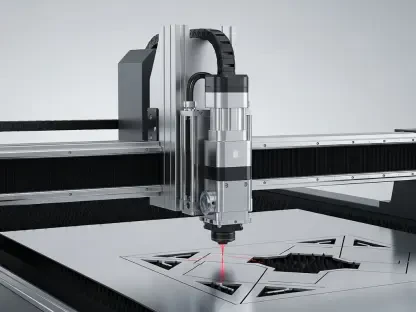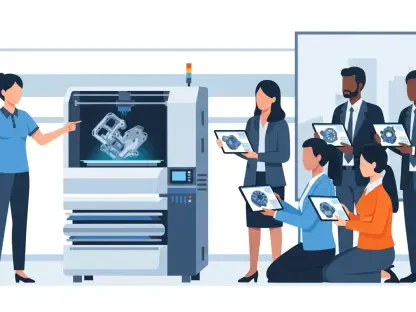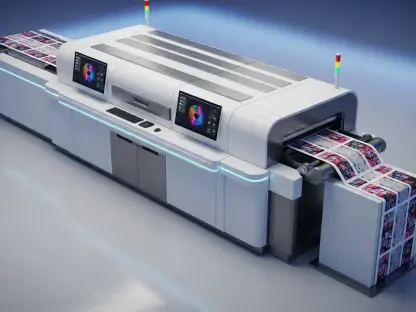Imagine a remote offshore oil rig in the middle of the North Sea, where a critical component fails, halting operations and costing thousands of dollars per hour in downtime. Traditional supply chains would require days or even weeks to deliver a replacement part, but what if that part could be produced on-site within hours using additive manufacturing (AM), commonly known as 3D printing? This scenario is no longer a distant dream, thanks to this transformative technology that is reshaping the energy sector, particularly in oil and gas, by enabling rapid, on-demand production of complex components. This review explores the capabilities, applications, and challenges of AM, shedding light on its potential to revolutionize energy operations.
Core Principles and Relevance in Energy
At its heart, additive manufacturing builds objects layer by layer, using digital models to create intricate designs that traditional subtractive methods struggle to achieve. Technologies such as selective laser melting and fused deposition modeling drive this process, allowing for the use of diverse materials ranging from polymers to high-strength metals. In the energy sector, AM stands out as a game-changer by slashing lead times and minimizing material waste, addressing long-standing inefficiencies in manufacturing critical equipment.
The significance of AM becomes even more pronounced when considering the unique challenges of oil and gas operations. Remote locations, harsh environments, and the need for bespoke components often strain conventional supply chains. By enabling localized production, AM not only reduces logistical burdens but also aligns with the broader wave of digital transformation sweeping through the industry, positioning itself as a vital tool for enhancing operational resilience.
Features and Performance of AM in Energy Operations
On-Demand Production in Challenging Settings
One of the standout features of AM in the energy sector is its capacity for on-demand manufacturing, particularly in remote or hostile environments. Portable 3D printers can be deployed directly to offshore rigs or desert drilling sites, producing spare parts or repair components as needed. This capability drastically cuts downtime, as operators no longer need to wait for shipments from distant warehouses, while also lowering transportation costs.
Performance metrics for on-site AM systems highlight their speed and adaptability. Many modern printers can fabricate functional parts within hours, with material compatibility extending to durable alloys suited for extreme conditions. However, limitations in print size and the need for skilled operators in such isolated areas remain hurdles that the industry continues to address through technological refinement and training programs.
Customization for Specialized Applications
Another key strength of AM lies in its ability to produce highly customized, high-value components tailored to specific energy applications. Subsea equipment, drilling tools, and turbine parts often require intricate geometries that are costly and time-intensive to manufacture traditionally. AM excels in delivering precision and strength, meeting stringent industry standards while enabling rapid iteration during the design phase.
Real-world examples underscore this advantage, with companies leveraging AM to craft bespoke solutions that enhance operational efficiency. For instance, intricate valve assemblies for subsea systems have been produced with reduced weight and improved performance, demonstrating how customization translates into tangible benefits. The flexibility to adapt designs quickly also supports innovation, allowing engineers to test novel configurations without prohibitive costs.
Emerging Developments and Industry Integration
The trajectory of AM in the energy sector is shaped by several emerging trends, notably its integration into the framework of Industry 4.0 and the concept of the “Digital Oilfield.” This convergence emphasizes smart manufacturing, where AM systems are paired with IoT devices and data analytics to create responsive, interconnected production ecosystems. Such advancements promise greater agility in addressing operational demands.
Collaboration across the supply chain is another driving force, with original equipment manufacturers, end-users, and service providers working together to refine AM applications. Events focused on AM for oil and gas serve as platforms for sharing insights on tailored solutions that meet sector-specific needs. These gatherings also spotlight the push toward resilient energy systems, where AM plays a pivotal role in ensuring continuity amid disruptions.
A critical area of focus is the development of advanced materials and processes to expand AM’s scope. Research efforts aim to overcome current constraints, such as limited material options for high-temperature or high-pressure environments. As these innovations unfold over the coming years, from 2025 onward, they are expected to unlock new possibilities for scaling AM in energy applications, further embedding it into mainstream operations.
Practical Implementations in Oil and Gas
In upstream oil and gas operations, AM has proven its worth by enabling rapid prototyping and production of critical components directly at the point of need. Companies like ExxonMobil and BP have adopted this technology to fabricate spare parts for drilling equipment, significantly reducing costs associated with inventory management and long lead times. This approach enhances flexibility, particularly in dynamic, high-stakes environments.
Subsea equipment manufacturing offers another compelling use case, where the ability to create complex, corrosion-resistant parts on demand is invaluable. Offshore rigs, often located far from supply hubs, benefit immensely from AM’s capacity to produce tools and replacements without delay. Such implementations not only boost efficiency but also mitigate risks tied to equipment failure in critical underwater operations.
Beyond immediate production needs, AM supports long-term strategic goals by fostering a leaner, more adaptive supply chain. The technology allows for digital inventories, where designs are stored electronically and printed only when required, slashing physical storage needs. This shift toward a more sustainable model aligns with industry efforts to optimize resources while maintaining operational uptime.
Challenges Hindering Wider Adoption
Despite its promise, AM faces several barriers to full integration in the energy sector, with material limitations topping the list. Not all materials currently used in AM can withstand the extreme conditions of oil and gas environments, such as high pressures and corrosive settings. Ongoing research seeks to bridge this gap, but progress remains incremental, constraining the range of applications.
Scalability poses another significant challenge, as current AM systems often struggle to produce large components or operate at the volumes needed for widespread deployment. Regulatory hurdles, including certification of printed parts for safety-critical uses, add further complexity. These technical and compliance issues demand coordinated efforts across industry stakeholders to establish standardized protocols.
Operational concerns, such as intellectual property protection and data security, also loom large in a distributed manufacturing landscape. The digital nature of AM raises risks of design theft or unauthorized replication, particularly when systems are deployed in remote areas with limited oversight. Addressing these vulnerabilities through robust cybersecurity measures and policy frameworks is essential to building trust in the technology.
Reflecting on the Impact and Path Forward
Looking back, this exploration of additive manufacturing in the energy sector reveals a technology brimming with potential, yet tempered by real-world constraints. Its ability to deliver on-demand production, customization, and alignment with digital transformation stands out as transformative, particularly for oil and gas operations. At the same time, challenges like material limitations and regulatory complexities underscore the work that remains to fully harness its capabilities.
Moving forward, industry stakeholders should prioritize investment in material science to expand AM’s applicability under extreme conditions. Collaborative initiatives, supported by platforms that bring together experts and decision-makers, can accelerate the development of standards and best practices. Embracing digital security measures will also be crucial to safeguard intellectual property as AM becomes more decentralized.
Ultimately, the journey of AM in energy points toward a future of greater efficiency and sustainability, provided the sector commits to overcoming existing barriers. Exploring pilot projects in varied operational contexts could offer valuable insights, paving the way for broader adoption. As technology evolves, staying engaged with emerging innovations will ensure that the energy industry maximizes the benefits of this groundbreaking approach.









